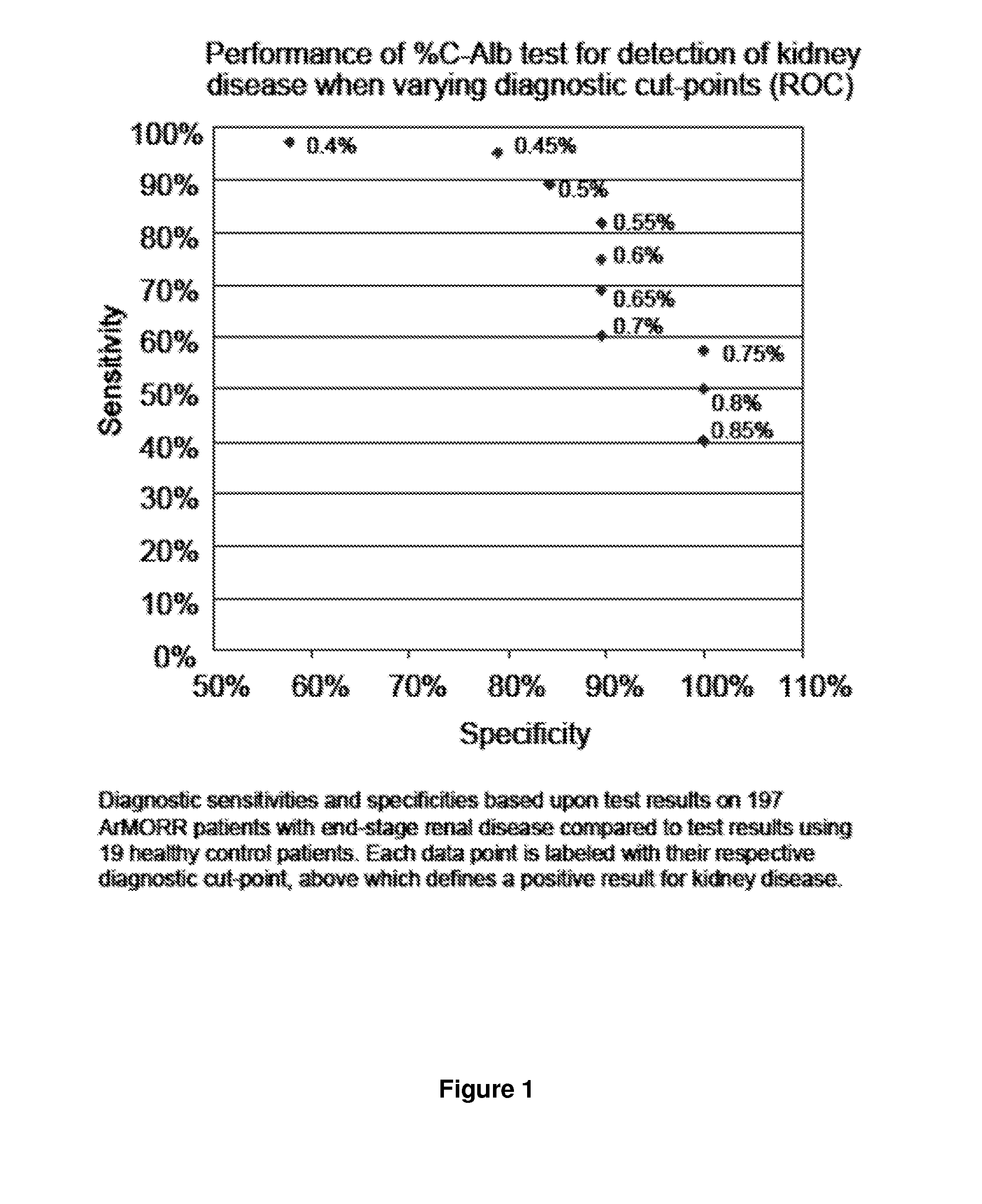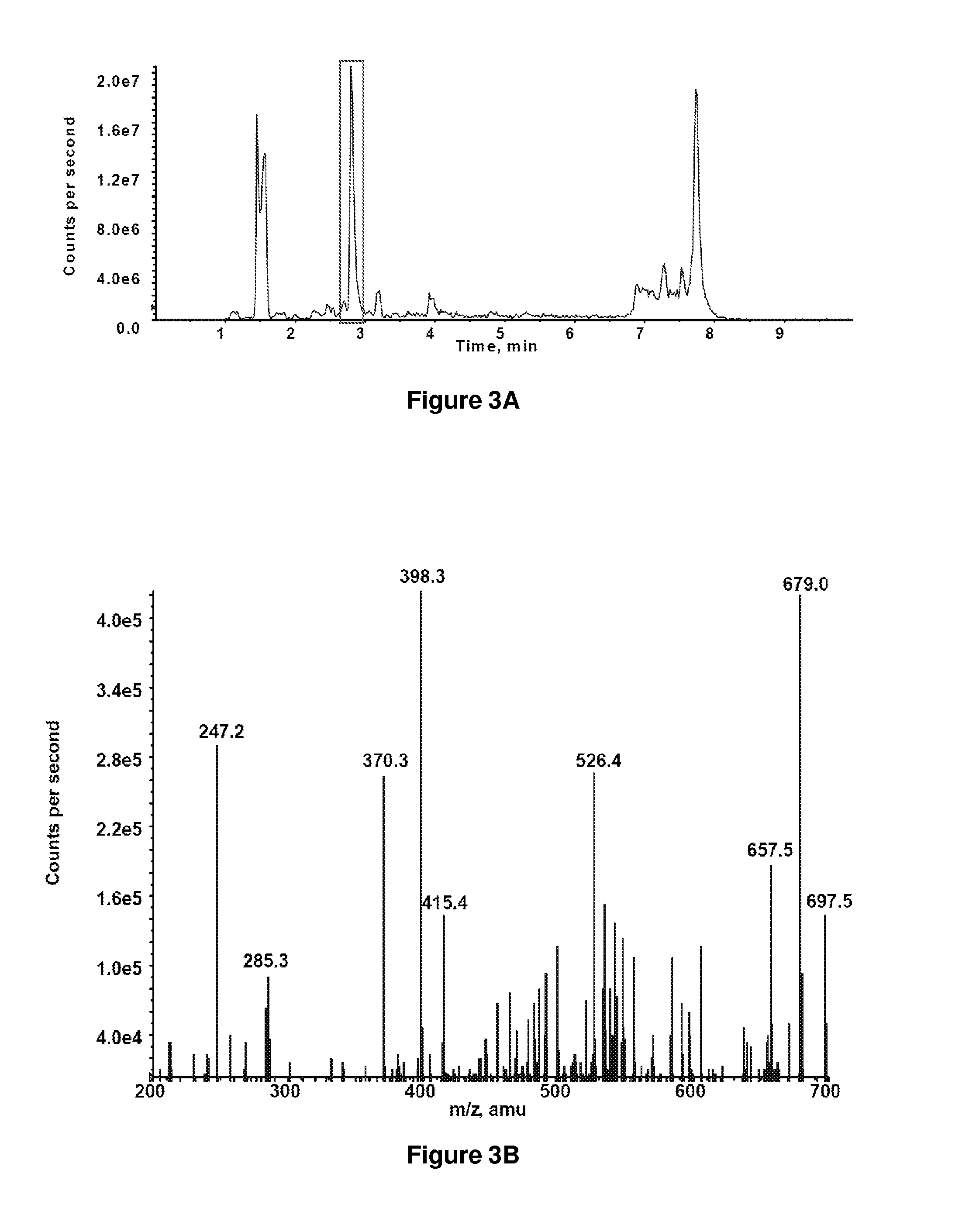Diagnosis, prognosis, and treatment of kidney disease
a kidney disease and prognosis technology, applied in the field of diagnosis, prognosis and treatment of kidney disease, can solve the problems of increasing the dose of dialysis of patients, retaining excess water, and reducing the frequency of occurrence or severity of kidney disease, and achieve the effect of reducing the frequency or severity
- Summary
- Abstract
- Description
- Claims
- Application Information
AI Technical Summary
Benefits of technology
Problems solved by technology
Method used
Image
Examples
example 1
Discovery of a Specific Site for Carbamylation of Human Serum Albumin
[0081]To map potential sites on circulating albumin susceptible to carbamylation, we reacted purified human serum albumin (HSA) with potassium cyanate (1 mM) in a physiologic buffer and digested with trypsin or endoproteinase Glu-C. Using reverse phase liquid chromatography and tandem mass spectrometry (product ion scan), we detected one predominant site with appreciable carbamylation at lysine 549. Peptide identification and localization of the carbamylated lysine were obtained by MS / MS ion search using the Mascot search engine, and confirmed by manual reconstruction from MS / MS spectra (FIGS. 3A-3D). When we tested serum albumin from patient samples, lysine 549 was the only detectable site of carbamylation. This finding was consistent with a recent report demonstrating that lysine 549 is most frequent site of glycation as well (Frolov et al., Anal. Bioanal. Chem. 397:2349-56, 2010). After our original observation ...
example 2
Assay Development for Carbamylated Albumin
[0083]We next developed methods for LC separation and MS / MS multiple reaction monitoring for our peptides of interest and isotopic peptide internal standards (FIG. 4). In order to apply this assay for the measurement of % C-Alb in patient samples, specimen processing and analysis methods were optimized, and the assay was calibrated by incorporation of isotopic peptide standards in the final method. The final assay method demonstrated excellent linearity (FIG. 5) and precision (coefficient of variation 4.2%). These methods are detailed below.
[0084]Carbamylation titration experiments were performed using an amino acid standard mix from Sigma Aldrich (Cat. No. AAS18) supplemented with tryptophan, cysteine, and glutamine; all amino acids were equimolar (2.5 mM stock). The 0.1 N HCl in the standard solution was neutralized with ammonium hydroxide and removed by lyophilization, and the dried amino acids were diluted to final concentration of 50 μM...
example 3
Serum Measurements of Carbamylated Albumin
[0087]After searching for candidate carbamylation sites in cyanate-treated albumin, we sought to test whether these modifications also occurred in vivo. LC-MRM methods described above were optimized to maximize their sensitivity, and then these methods were used to analyze patient serum samples (using serum from patients with uremic kidney disease as well as from healthy controls). Because lysine 549 was also the only detectable site of carbamylation in patient samples, we focused on this site.
[0088]To measure carbamylated albumin, serum samples were thawed at room temperature and spun at 14,000 rpm for 10 minutes to remove clots and precipitates. 3 μl of cleared serum was diluted into 100 μl of 8 mM dithiothreitol and 1 mM EDTA and heated to 80° C. for 20 minutes in order to denature and reduce disulfide bonds, then allowed cool. 50 μl aliquots of denatured serum were mixed 1:1 with 200 mM ammonium bicarbonate (pH 7.8) and isotopic peptide ...
PUM
| Property | Measurement | Unit |
|---|---|---|
| temperature | aaaaa | aaaaa |
| pH | aaaaa | aaaaa |
| flow rate | aaaaa | aaaaa |
Abstract
Description
Claims
Application Information
 Login to View More
Login to View More - R&D
- Intellectual Property
- Life Sciences
- Materials
- Tech Scout
- Unparalleled Data Quality
- Higher Quality Content
- 60% Fewer Hallucinations
Browse by: Latest US Patents, China's latest patents, Technical Efficacy Thesaurus, Application Domain, Technology Topic, Popular Technical Reports.
© 2025 PatSnap. All rights reserved.Legal|Privacy policy|Modern Slavery Act Transparency Statement|Sitemap|About US| Contact US: help@patsnap.com



